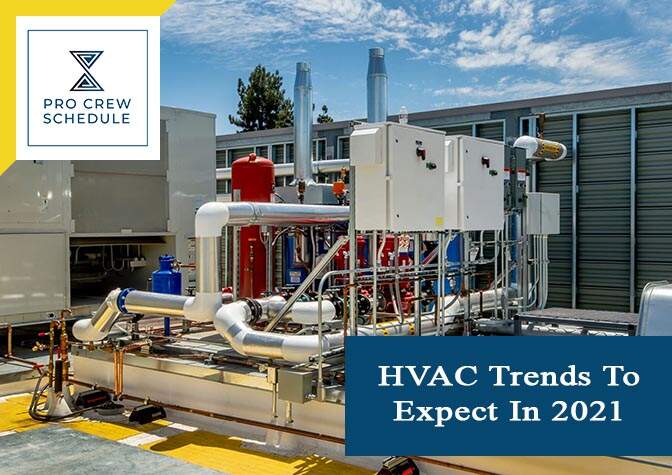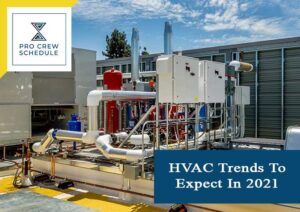As the new year begins, the industry is about to get a whole lot of changes. Whether you’re a construction manager in charge of construction crew management, a subcontractor for an HVAC company, or a worker doing all the heavy lifting, you will see plenty of new trends in construction training and project management that is fit for everyone.
For those managing construction projects and working on them, we’ve done a couple of articles about 2021 trends for construction in general, “Construction Technology: What To Expect For 2021” and “Construction Technology Trends: Looking Ahead to 2021.” But for this one, let’s take a look at what 2021 has to offer one trade in particular: HVAC.
The need for better air quality
Global climate and air quality have been a topic of concern for some time now. But with the significant event that happened in 2020, they have become such a priority. Although the HVAC industry has always been focused on providing indoor comfort through heating and cooling, it will now shift more towards the building’s occupants’ safety, health, and well-being.
With that, we should expect to see developments regarding improving air quality. Upgrading air filters is one to look forward to. Even though there was a recent upgrade in all filter media in 2020, it’s safe to say that there will be more advances in the coming years.
More than that, with the advancements in technology and the heavy reliance on the Internet, remote climate control will be on a new level. Smart HVAC systems are not new to the scene. For years, homeowners and building managers have been remotely controlling the building’s climate. More recent systems even can sense and learn to fit the occupants’ needs better and wants. But with air quality and health as concerns, there could be a new app or at least a new feature where residents can check on the “air health.”
While there will be other areas of concern, the HVAC field’s focus going into 2021 will be improving air quality. From there, the majority of trends will emerge.
2021 HVAC Trends
1. SaaS (Software as a service)
Software as a service (SaaS), is software that users (i.e., companies) can customize and subscribe to so they don’t have to spend to develop their own. This has been floating around for a while in the construction industry and among most of the trades. Software for project management and crew scheduling is being used to increase efficiency and improve organization. Pro Crew Schedule has an array of software made for several trades, one of which is HVAC. Expanding SaaS further gives new opportunities for manufacturers and contractors.
In the HVAC field, contractors can use software, widgets, and SEO to widen their market by connecting to different communities. SaaS has been commonly used for commercial and industrial buildings. But with the increasing number of residential structures, and the need to go green and be sustainable, SaaS will become relevant.
2. Smart systems and mobile controls
Smart HVAC systems have been in the game for quite some time. Primarily for its convenience, these systems have been installed for building occupants. And with products like Nest Thermostats and Daikin Control Systems, smart systems’ appeal is likely to increase.
These products allow users to control almost every aspect of their home from a central hub, usually their smartphone with the appropriate app. Because they can remotely control the smart devices, such as an interactive fridge or thermostat, residents would also be saving energy and money. More than that, these smart systems can also learn, thus adjusting themselves to cater to the users’ wants and needs.
With the possibility of ease and efficiency right in their hands, smart HVAC systems’ demand will continue to rise.
3. Continued rise of green technology
In recent years, going green has become more of a necessity than merely a trend. Governments are even focusing on green technology, implementing stricter environmental regulations. Because of this, project managers and contractors will have an incentive to look for sustainable solutions. This adopting of renewable resources will help companies transition from traditional systems to hybrid models.
On top of stricter environmental regulations, these systems’ cost benefits will push the industry toward renewable and sustainable energy resources. While there will be a significant impact on the HVAC field, the transition to hybrid would be reasonably smooth as minimal building refurbishment is required. This will then lead to large-scale and cost-effective decreases in greenhouse gas emissions.
Moreover, HVAC is not limited to the mechanical aspect but also includes how buildings retain heat. With people spending most of their time indoors, heating bills have significantly increased. This is why 2021 will be a year when energy efficiency takes a giant leap.
There’s a wide selection of options for a moisture-free, healthy-living interior. Baumit has a range of lime and silicate-based plasters that are permeable to vapor. They are also low in emissions and provide an eco-friendly and breathable plaster for interiors.
4. Inverter technology
Inverter technology will become a staple in HVAC solutions as going green and becoming sustainable goes higher on the priority list.
Essentially, inverter technology quickly cools and warms a room to the desired temperature and efficiently maintains this. This kind of regulation system prolongs the component’s life cycle, improves efficiency, and aids in eliminating sharp fluctuations in the load from the AC on the power supply.
5. Proactive perspective on maintenance
In many of our previous articles, we have emphasized the importance of proper maintenance of HVAC systems. But with the increase in operational costs, property owners, be it residential or commercial, are urged to look for proactive ways to reduce expenses in system repairs and replacements and make their systems energy efficient.
The most effective way to achieve this goal is with a good HVAC maintenance plan, which can decrease energy costs by 5% to 40% and substantially reduce replacement and repair costs. Expect to see this market grow in 2021 as homeowners and building managers open up to the idea of investing in maintenance programs.
6. Integration of VR and AR technologies
Virtual and augmented reality are relatively new developments in technology but have already circulated multiple industries, and HVAC is quickly hopping on the bandwagon.
Designing systems is an intricate and complex job, mostly having to do it in 2D. You only get to see it firsthand when you get on-site and see it being built. But with virtual reality (VR) and augmented reality (AR), design engineers have now changed how they plan and demo their systems in real-time.
With this technology, engineers and technicians don’t have to work with 2D drawings. Instead, they can see in real-life every single component, from the smallest screw to the largest AC unit, and how they work in the system. They are able to visualize the simulated system with the help of rendering technology and the latest CAD software.
VR and AR can also help with HVAC training and maintenance. Trainees can see firsthand how systems work and how to fix them without having to compromise their safety. Alternatively, service technicians can see and fix a problem before they even get to the job.
In a dynamic and fast-moving industry such as HVAC, VR and AR technology is a welcomed development.
7. New kind of training
New and updated training is needed for future tradespeople with all the new technology and trends coming up. From 2021, global demands for HVAC equipment are predicted to increase by about 6% yearly. With the growth of the market, there will also be a higher demand for skills in companies.
As the baby boomers are nearing retirement, the HVAC industry is experiencing a severe labor shortage. Unfortunately, the millennial and Gen Z generations are not likely to make a career in the trade. So, companies are evaluating how they recruit and train their staff. They are now investing more time and resources in skills programs and employee training to adapt to change.
Anything can happen in 2021
This past year has proved that anything can happen, be it bad or good. On the one hand, the unpredictability of the coming years can be scary and dangerous. Without any idea of what’s to come, it will be tough to prepare for that, primarily if it resides on the spectrum’s negative side. On the other hand, however, it is also an exciting time, not knowing what the future holds.
The point is that even with these trends predicted to be picked up in 2021; nothing is set in stone. There is a high possibility that the HVAC industry will adopt these trends as expected. But because of the ever-evolving and ever-changing times, there will certainly be a handful of trends and technologies popping up that no one expected.
Be that as it may, the HVAC industry is fully capable of adapting to the times, albeit challenging at first.







